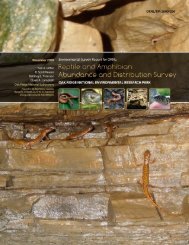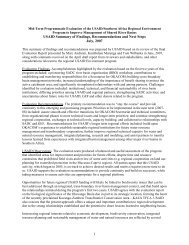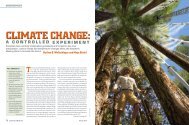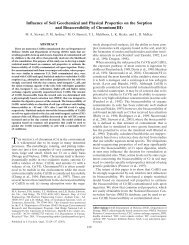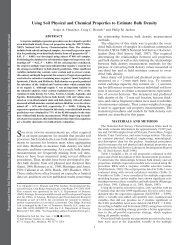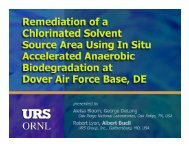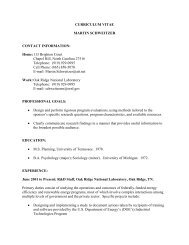oak ridge reservation physical characteristics and natural resources
oak ridge reservation physical characteristics and natural resources
oak ridge reservation physical characteristics and natural resources
You also want an ePaper? Increase the reach of your titles
YUMPU automatically turns print PDFs into web optimized ePapers that Google loves.
Two broad hydrologic units have been identified on the ORR: (1) the Knox Aquifer, which<br />
includes the Maynardville Limestone <strong>and</strong> is highly permeable, <strong>and</strong> (2) the ORR Aquitards, which<br />
consist of less permeable geologic units. The geologic regime referred to as the ORR Aquitards<br />
comprises bedrock <strong>and</strong> residuum of the Cambrian-age Rome Formation <strong>and</strong> Conasauga Group<br />
(excluding the Maynardville Limestone) <strong>and</strong> the Chickamauga Group. Bedrock included in these<br />
formations is predominantly clastic sediment (shales, siltstones, well-cemented s<strong>and</strong>stones, <strong>and</strong><br />
clayey to silty limestones). The ORR Aquitards include local zones in which groundwater occurs in<br />
quantities sufficient to provide a potential resource of limited use. These zones typically occur within<br />
karstic carbonate members of the clastic bedrock formations. Although marginal localized<br />
groundwater <strong>resources</strong> occur within the ORR Aquitards, these formations are far less important to<br />
regional water <strong>resources</strong>—including being a source of potable water for private <strong>and</strong> public water<br />
supply <strong>and</strong> a source of baseflow to regional surface water bodies—than is the Knox Aquifer.<br />
Portions of the ORR underlain by carbonate bedrock commonly exhibit karst geomorphic<br />
features. About 60% of the ORR is underlain by carbonate-dominated bedrock. Karst geomorphic<br />
features form in carbonate-rich bedrock <strong>and</strong> are evident as sinkholes, solution caverns, <strong>and</strong> sinking<br />
creeks. In addition to creation of subsurface voids in bedrock, the weathering process leaves behind<br />
the insoluble mineral components of the rock that combine with organic residues of decaying plant<br />
materials to form a soil mantle over most of the ORR. The soil mantle forms a <strong>physical</strong> <strong>and</strong><br />
geochemical filter that reduces the direct infiltration of rainfall <strong>and</strong> contaminants into the groundwater<br />
system. Geochemical retardation of contaminants in the soil mantle reduces the mobility of many<br />
types of contaminants. Groundwater flow in most of the carbonates is quite different from flow in<br />
porous media, in which advective flow conditions largely govern flow <strong>and</strong> solute transport.<br />
Groundwater flow in karst terranes manifests itself in multiple scales of porosity, such as diffusion in<br />
intergranular pores of weathered or inherently porous bedrock, flow by seepage in rock fractures with<br />
water <strong>and</strong> rock matrix interaction on fracture surfaces, or flow in conduits in which rapid velocities<br />
limit the interaction between the water <strong>and</strong> bedrock. Groundwater discharge from springs <strong>and</strong> seeps is<br />
abundant on the ORR <strong>and</strong> accounts for the normal baseflow of <strong>natural</strong> stream systems in the area.<br />
Most recharge to the groundwater system occurs through dispersed percolation of rainwater through<br />
the soil mantle <strong>and</strong> through capture in surface dolines (i.e., sinkholes) during the winter <strong>and</strong> early<br />
spring months, when evapotranspiration losses of soil moisture are negligible. Groundwater storage in<br />
thick soil profiles <strong>and</strong> in the weathered bedrock zone of the Knox Group outcrop areas such as<br />
Black<strong>oak</strong>, Chestnut, <strong>and</strong> Copper Ridges provides most of the dry-season baseflow <strong>and</strong> feeds the<br />
area’s largest springs. Most groundwater flow in the carbonate bedrock groundwater basins on the<br />
ORR originates as intergranular or fracture seepage through the soil mantle, <strong>and</strong> flow progresses<br />
through coalescing networks of conduits that culminate at spring discharges. Baseflow springs often<br />
occur near major geologic outcrop boundaries, where semiconfining bedrock lithologies tend to limit<br />
the orientation of conduit development <strong>and</strong> promote upward flow of groundwater to discharge at the<br />
l<strong>and</strong> surface. In portions of the ORR underlain by shale-rich bedrock, such as the Conasauga Group<br />
bedrock of Bear Creek Valley <strong>and</strong> Melton Valley, groundwater seepage is typically through fractures<br />
in weathered bedrock with discharge to nearby streams. Discrete baseflow springs are not common in<br />
the shale-dominated outcrop areas; however, small seeps are abundant.<br />
6.2 UNSATURATED ZONE HYDROLOGY<br />
Because ORR l<strong>and</strong>forms consist almost entirely of sloping l<strong>and</strong> surfaces, the concepts of<br />
hillslope hydrology may be used to describe the active hydrologic process. Based on soil percolation<br />
capacity <strong>and</strong> soil structure, as well as direct measurement of water transmission in soil test areas, it is<br />
estimated that in undisturbed, <strong>natural</strong>ly vegetated areas on the ORR, about 90% of the infiltrating<br />
precipitation does not reach the water table but travels through the 3- to 6.5-ft (1- to 2-m) storm-flow<br />
zone, which approximately corresponds to the root zone. This condition exists because of the<br />
permeability contrast between the shallow storm-flow zone <strong>and</strong> the underlying unsaturated zone.<br />
14




